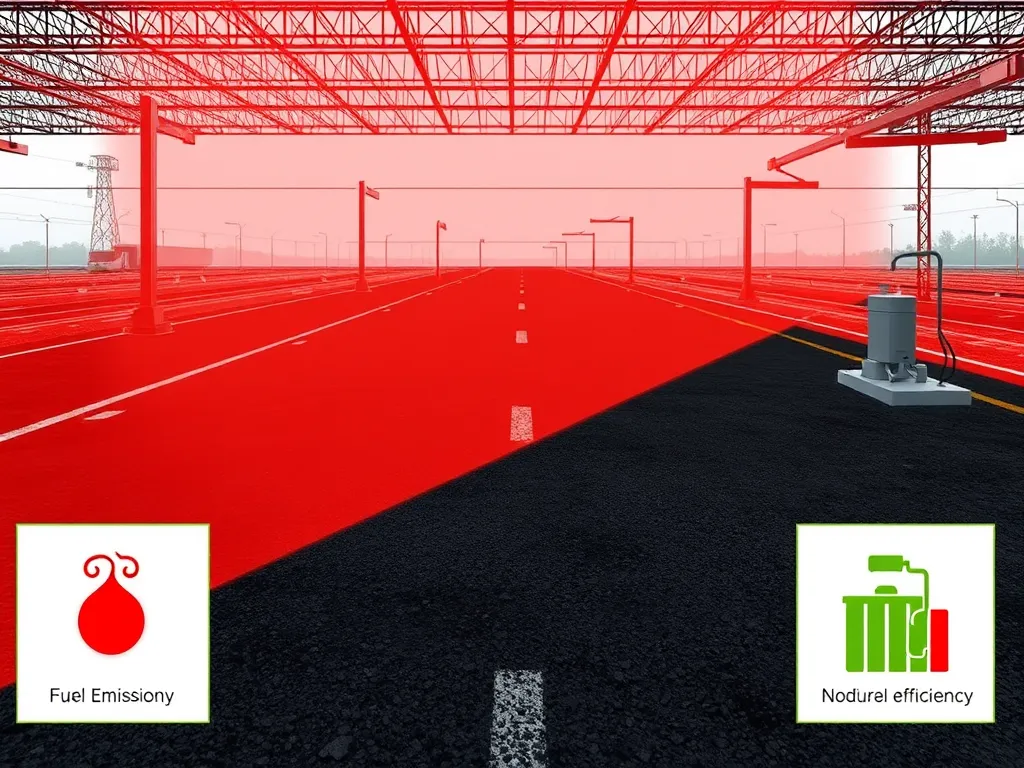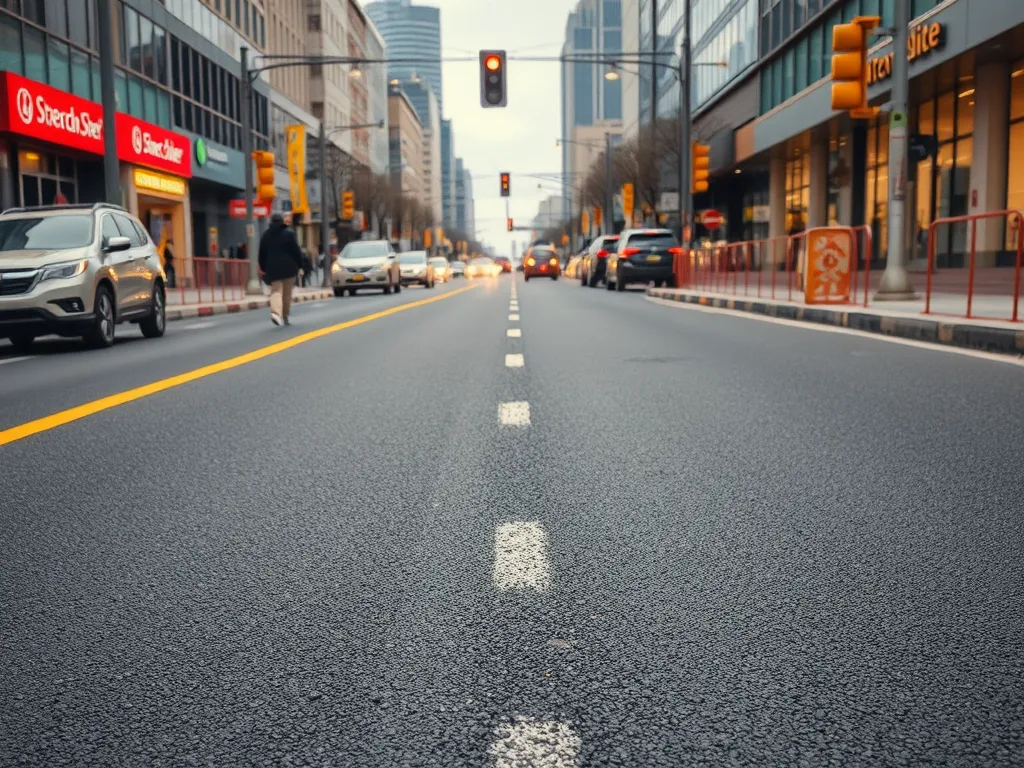Benefits Of Using Infrared Heating for Asphalt
Published on: August 28, 2025 | Last Updated: April 14, 2025
Written By: George Voss
Infrared heating for asphalt repairs uses targeted thermal energy to heat damaged surfaces, allowing seamless fixes without full-depth replacement. Unlike traditional methods that remove old asphalt, infrared technology softens existing material. This bonds new and old layers at the molecular level, creating stronger patches. Contractors choose it for faster work, 30–50% lower costs, and 90% less waste. This article explains how infrared heating cuts project time, reduces environmental impact, and extends pavement life.
We’ll explore how infrared systems heat asphalt to 300–350°F in minutes, compare them to cold patching or milling, and show their role in pothole repairs, crack sealing, and recycling. You’ll see why cities and businesses use it for parking lots, roads, and driveways. Data, cost breakdowns, and real examples are included.
Contents
- What is Infrared Heating for Asphalt?
- Key Advantages Of Infrared Heating in Asphalt Repair
- Infrared Heating Vs. Traditional Asphalt Repair Methods
- Common Applications Of Infrared Heating in Asphalt Maintenance
- Frequently Asked Questions (FAQs)
- Frequently Asked Questions (FAQs)
- Closing Thoughts
- Additional Resources for You:
What is Infrared Heating for Asphalt?
Infrared heating employs electromagnetic waves to warm asphalt surfaces without direct contact. This method targets specific repair zones, softening aged pavement to restore flexibility. Temperatures typically reach 300-400°F, reactivating the bitumen binder for seamless integration with new material. Unlike torch-based methods, this approach eliminates open flames, reducing fire hazards and emissions.
How Infrared Technology Works on Asphalt Surfaces
Infrared heaters emit waves that penetrate 1-2 inches into the pavement. The energy transfers directly to aggregates and bitumen, restoring malleability without burning. Built-in sensors monitor surface temps, adjusting output to maintain optimal heat levels. Once pliable, crews rake the softened asphalt, add fresh mix, and compact the area. This eliminates cold joints, a common weak spot in traditional patches.
Core Components Of Infrared Asphalt Heating Systems
Key elements drive these systems: emitter panels (ceramic or quartz), reflector shields, digital controls, and thermal cameras. Emitter panels generate focused heat, while reflectors concentrate energy on target areas. Digital controls allow precise temp adjustments (±5°F), and thermal cameras map surface conditions. Combined, these parts enable uniform heating at 2-3 sq.ft per minute, minimizing material waste by 90% compared to excavation.
With the science behind the technology clear, let’s explore how these features translate into measurable advantages for repair crews and project owners.
Key Advantages Of Infrared Heating in Asphalt Repair
Infrared heating transforms asphalt repair by addressing core challenges in road maintenance. Let’s break down its measurable benefits.
Rapid Heating and Reduced Project Downtime
Infrared heaters reach 300°F–350°F in under 10 minutes, softening asphalt 2-3 inches deep. This cuts pre-repair heating time by 70% compared to traditional methods. Roads reopen within 30-60 minutes post-repair—ideal for high-traffic zones like intersections or hospital driveways.
Cost-effective Repairs and Long-term Savings
Infrared repairs cost 20-40% less per square foot than full-depth replacements. Savings come from two key areas:
Lower Labor and Material Expenses
Crews shrink from 5-7 workers to 1-3. No saw-cutting or heavy machinery reduces labor costs by 30-50%. Existing asphalt reuse eliminates fresh aggregate purchases, saving $15-$25 per ton.
Minimized Asphalt Waste Generation
Traditional methods waste 15-20% of removed asphalt. Infrared repairs reuse 95%+ of existing material. One mile of road repair prevents 45-60 tons of landfill waste annually.
Enhanced Durability and Seamless Surface Integration
Infrared creates molecular bonds between old and new asphalt layers. Repaired areas show 90%+ shear strength retention versus original surfaces. No seams mean 80% less water infiltration—critical for freeze-thaw regions like the Midwest.
Energy Efficiency and Reduced Environmental Footprint
Infrared systems use 40-60% less fuel than hot-mix asphalt plants. A typical 500kW heater emits 1.2 tons CO2 per project vs 3.5 tons for conventional methods. Recycled asphalt reduces virgin bitumen demand by 30%, preserving 2.5 barrels of oil per ton reused.
While these benefits highlight infrared’s strengths, how does it stack up against conventional repair techniques? Let’s compare performance metrics side by side.

Infrared Heating Vs. Traditional Asphalt Repair Methods
Infrared heating reshapes how crews fix pavement by focusing energy directly on damaged zones. Traditional methods require removing cold sections or pouring fresh mix over compromised surfaces. Let’s break down why infrared outperforms older techniques.
Comparison Of Repair Speed and Labor Requirements
Infrared systems heat pavement to 300°F in 5-10 minutes, softening existing binder for immediate reshaping. Crews complete most repairs in under 30 minutes without waiting for new materials to cure. Traditional cold milling or removal demands 3-5 workers, while infrared jobs need 1-2 trained operators. Projects finish up to 75% faster, cutting labor costs by 40%.
Material Usage and Waste Generation Differences
Infrared recycling reuses 90-100% of existing pavement, eliminating disposal fees for torn-out chunks. Traditional repairs generate 150-300 lbs of waste per pothole. New mix production drops by 60% with infrared since crews blend heated material instead of layering fresh over old. This slashes CO2 emissions linked to hot-mix plants by 35% per ton saved.
Longevity and Performance Of Repaired Asphalt
Thermal bonding creates seamless joints between heated zones and surrounding pavement. Infrared-restored surfaces withstand freeze-thaw cycles 30% longer than patched spots, based on 2022 TxDOT field tests. Water infiltration—the main cause of pothole recurrence—drops by 80% compared to cold-pour fixes. Repaired sections often outlast surrounding pavement due to restored flexibility.
With faster turnaround times, lower resource needs, and stronger results, infrared systems redefine modern pavement care. Next, let’s explore specific scenarios where this technology shines brightest.
Also See: Community Awareness on Asphalt Impacts: Act Now!
Common Applications Of Infrared Heating in Asphalt Maintenance
Infrared heating systems tackle multiple asphalt issues with precision. From fixing potholes to recycling materials, this technology adapts to diverse repair needs while cutting costs and boosting sustainability.
Pothole Repair and Surface Restoration
Infrared heaters soften damaged asphalt at 300°F–350°F, reactivating the binder in existing pavement. Crews blend new asphalt with the heated surface, creating thermal bonds that prevent water infiltration. This method fixes potholes in 15–30 minutes per square yard, reducing traffic delays. Cities like Denver report 40% lower repeat repairs compared to cold-patch techniques.
Crack Sealing and Joint Repairs
Targeted infrared heat prepares cracked asphalt for seamless sealing. The process warms surfaces to 250°F, allowing fresh binder to fuse with aged material. Joints between pavement sections regain flexibility, resisting temperature-induced stress. Contractors save 50% on sealant use by heating only affected areas instead of full-width lanes.
Recycling and Reusing Existing Asphalt Materials
Infrared heating reclaims 100% of existing pavement during repairs. No milling or removal is needed—heated asphalt becomes workable again, blending with new mix. This slashes material costs by $12–$18 per ton and cuts landfill waste by up to 90%. Projects using 30% recycled asphalt pay 22% less in total expenses while meeting ASTM D6925 specs.
| Application | Material Savings | Time Reduction |
|---|---|---|
| Pothole Repair | 60% Less New Asphalt | 75% Faster |
| Crack Sealing | 50% Less Sealant | 40% Faster |
| Recycling | 100% Reuse Rate | 60% Faster |
Infrared heating’s versatility makes it a go-to solution for asphalt teams. Let’s explore how it stacks against traditional methods in speed, cost, and durability.

Frequently Asked Questions (FAQs)
Got questions about infrared heat for asphalt fixes? We’ve got clear, straight answers.
How Does an Infrared Asphalt Heater Work?
Infrared heaters use panels that send out heat waves. These waves warm asphalt to 300-350°F in minutes. This softens the binder (the sticky glue in asphalt) so crews can rake, level, and blend new mix with old. No haul-off of old asphalt. No cold spots.
Is Infrared Asphalt Repair More Cost-effective Than Traditional Methods?
Yes. Cut labor time by 40% since crews skip steps like cutting edges or hauling debris. Save $3-$7 per square foot by reusing 95% of existing asphalt. No need for fresh binder in most cases. Less gear, fewer workers.
Can Hot Asphalt Bond Properly With Infrared-heated Existing Surfaces?
Yes. Infrared heat brings old asphalt to the same temp as new hot mix (280-300°F). This creates a seamless bond. Tests show shear strength over 350 psi – same as untouched pavement. No weak seams that crack in cold weather.
Does Infrared Asphalt Repair Deliver Long-term Results?
Infrared fixes last 5-8 years vs 2-3 years for cold patches. Thermal bonding stops water from seeping under repairs. Less freeze-thaw damage. Roads stay smooth with no “patch bounce” from uneven layers.
Still weighing options? See how cities and contractors get real-world wins with infrared heat.
Frequently Asked Questions (FAQs)
Got questions about infrared heating for asphalt repairs? We’ve got clear, straightforward answers.
How Does an Infrared Asphalt Heater Work?
Infrared heaters utilize panels that emit heat waves, warming asphalt to temperatures of 300-350°F within minutes. This process softens the binder, allowing crews to rake, level, and blend new mix with the existing asphalt without hauling off old material or creating cold spots.
Is Infrared Asphalt Repair More Cost-effective Than Traditional Methods?
Yes, infrared asphalt repair is generally more cost-effective. It can reduce labor time by 40% as crews eliminate steps like cutting edges or transporting debris. Additionally, reusing 95% of existing asphalt results in savings of $3-$7 per square foot, minimizing the need for new binder and equipment.
Can Hot Asphalt Bond Properly With Infrared-heated Existing Surfaces?
Absolutely. The infrared heating process brings the temperature of old asphalt in line with that of new hot mix (approximately 280-300°F), facilitating a strong, seamless bond. Tests indicate shear strength above 350 psi, comparable to undisturbed pavement, which mitigates the risk of weak seams that can crack in colder weather.
Does Infrared Asphalt Repair Deliver Long-term Results?
Infrared repairs typically last between 5 to 8 years, compared to just 2 to 3 years for traditional cold patches. The thermal bonding process prevents water infiltration underneath repairs, significantly reducing freeze-thaw damage and ensuring roads remain smooth while avoiding issues like “patch bounce” caused by uneven layering.
What Kind Of Environment is Best for Infrared Asphalt Repair?
Infrared asphalt repair can be performed in various environments, including both urban and rural settings. It’s particularly beneficial in high-traffic areas where rapid turnaround is essential. However, for optimal results, it’s recommended to carry out repairs in dry weather conditions to ensure the surface is free of moisture.
How Long Does the Infrared Heating Process Take?
The infrared heating process is quick, typically taking about 5-10 minutes to heat the asphalt to the desired temperature. Once heated, repairs can be completed within 30-60 minutes, allowing for a swift reopening of the road to traffic, which is an excellent advantage in busy areas.
Can Infrared Heating Be Used for All Types Of Asphalt Repairs?
While infrared heating is highly effective for many types of asphalt repairs—including pothole fixes, crack sealing, and surface restoration—it may not be suitable for all situations. For instance, significant structural damage may require traditional methods or full-depth replacements. It’s best to assess each case individually.

Closing Thoughts
Infrared heating offers numerous advantages for asphalt applications. The technology accelerates repair processes, cuts costs, and enhances durability. With minimal environmental impact, it stands out as a forward-thinking solution for asphalt maintenance.
From pothole repairs to crack sealing, the benefits are clear. Infrared heating not only improves efficiency but also supports sustainability by recycling existing materials. This method leads to strong and seamless asphalt surfaces, ensuring long-lasting results.
For more information on the benefits and applications of infrared heating in asphalt, visit Asphalt Calculator USA.
Additional Resources for You:
- Lavin, P. (2003). Asphalt Pavements: A Practical Guide to Design, Production, and Maintenance for Engineers and Architects. London: Taylor & Francis.
- Infrared Asphalt Repair Equipment For Sale | Asphalt Sealcoating Direct
- How Does Infrared Asphalt Repair Work? – ACI Asphalt & Concrete
- Why Infrared Asphalt Repair is a Sustainable Option for Pavement – Richfield Blacktop
- Infrared Heater for Asphalt Patching | Asphalt Kingdom


